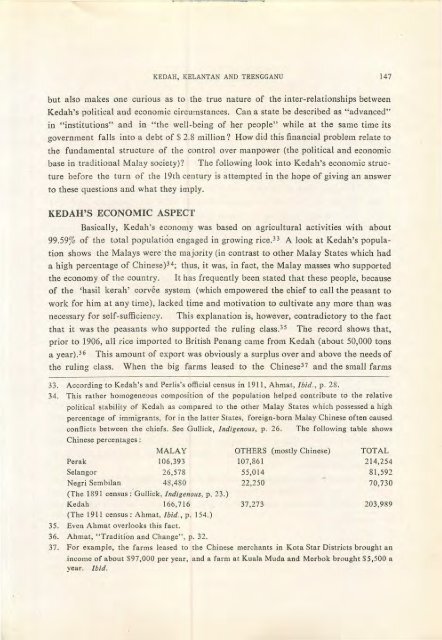The Journal of the Siam Society Vol. LXXII, Part 1-2, 1984 - Khamkoo
The Journal of the Siam Society Vol. LXXII, Part 1-2, 1984 - Khamkoo
The Journal of the Siam Society Vol. LXXII, Part 1-2, 1984 - Khamkoo
You also want an ePaper? Increase the reach of your titles
YUMPU automatically turns print PDFs into web optimized ePapers that Google loves.
KEDAR, KELANTAN AND TRENGGANU 147<br />
but also makes one curious as to <strong>the</strong> true nature <strong>of</strong> <strong>the</strong> inter-relationships between<br />
Kedah's political and economic circumstances. Can a state be described as "advanced"<br />
in "institutions" and in "<strong>the</strong> well-being <strong>of</strong> her people" while at <strong>the</strong> same time its<br />
government falls into a debt <strong>of</strong> $ 2.8 million? How did this financial problem relate to<br />
<strong>the</strong> fundamental structure <strong>of</strong> <strong>the</strong> control over manpower (<strong>the</strong> political and economic<br />
base in traditional Malay society)?<br />
<strong>The</strong> following look into Kedah's economic structure<br />
before <strong>the</strong> turn <strong>of</strong> <strong>the</strong> 19th century is attempted in <strong>the</strong> hope <strong>of</strong> giving an answer<br />
to <strong>the</strong>se questions and what <strong>the</strong>y imply.<br />
KEDAR'S ECONOMIC ASPECT<br />
Basically, Kedah's economy was based on agricultural activities with about<br />
99.59% <strong>of</strong> <strong>the</strong> total population engaged in growing rice.33 A look at Kedah's population<br />
shows <strong>the</strong> Malays were'<strong>the</strong> majority (in contrast to o<strong>the</strong>r Malay States which had<br />
a high percentage <strong>of</strong> Chinese) 34 ; thus, it was, in fact, <strong>the</strong> Malay masses who supported<br />
<strong>the</strong> economy <strong>of</strong> <strong>the</strong> country. It has frequently been stated that <strong>the</strong>se people, because<br />
<strong>of</strong> <strong>the</strong> 'hasil kerah' corvee system (which empowered <strong>the</strong> chief to call <strong>the</strong> peasant to<br />
work for him at any time), lacked time and motivation to cultivate any more than was<br />
necessary for self-sufficiency. This explanation is, however, contradictory to <strong>the</strong> fact<br />
that it was <strong>the</strong> peasants who supported <strong>the</strong> ruling class. 35 <strong>The</strong> record shows that,<br />
prior to 1906, all rice imported to British Penang came from Kedah (about 50,000 tons<br />
a year).36 This amount <strong>of</strong> export was obviously a surplus over and above <strong>the</strong> needs <strong>of</strong><br />
<strong>the</strong> ruling class. When <strong>the</strong> big farms leased to <strong>the</strong> Chinese37 and <strong>the</strong> small farms<br />
33 . According ·to Kedah's and Perl is's <strong>of</strong>ficial census in 1911, Ahmat, Ibid., p . 28.<br />
34. This ra<strong>the</strong>r homogeneous composition <strong>of</strong> <strong>the</strong> population helped contribute to <strong>the</strong> relative<br />
political stability <strong>of</strong> Kedah as compared to <strong>the</strong> o<strong>the</strong>r Malay States which possessed a high<br />
percentage <strong>of</strong> immigrants, for in <strong>the</strong> latter Sta tes, foreign-born Malay Chinese <strong>of</strong>ten caused<br />
conflicts between <strong>the</strong> chiefs. See Gullick, Indigenous, p. 26. <strong>The</strong> following table shows<br />
Chinese percentages :<br />
Perak<br />
MALAY<br />
106,393<br />
Selangor 26,578 55,014<br />
Negri Sembilan 43,480 22,250<br />
(<strong>The</strong> 1891 census :'Gullick, Indigenous, p. 23.)<br />
Kedah 166,716 37,273<br />
(<strong>The</strong> 1911 census: Ahmat, Ibid., p . 154.)<br />
35. Even Ahmat overlooks this fact.<br />
36. Ahmat, "Tradition and Change", p. 32.<br />
OTHERS (mostly Chinese)<br />
107,861<br />
TOTAL<br />
2 14,254<br />
81,592<br />
70,730<br />
203,989<br />
37. For example, <strong>the</strong> farms leased to <strong>the</strong> Chinese merchants in Kota Star Districts brought an<br />
.income <strong>of</strong> about $97,000 per year, and a farm at Kuala Muda and Merbok brought $ 5,500 a<br />
year. Ibid.

















